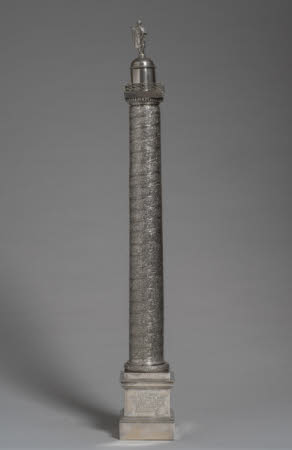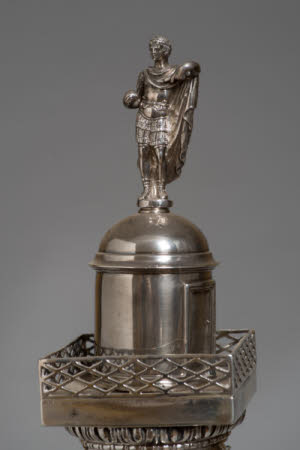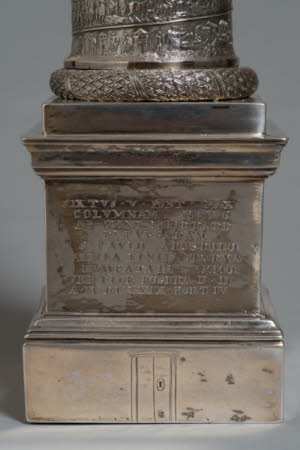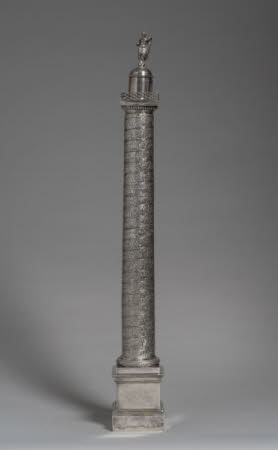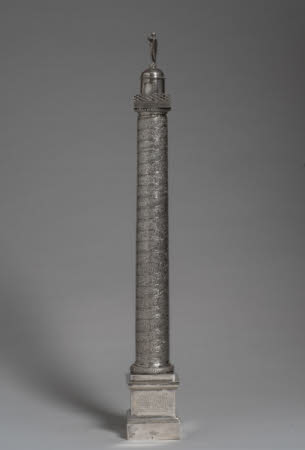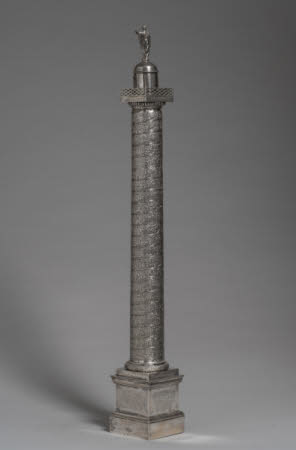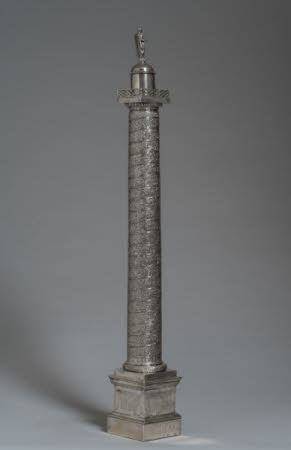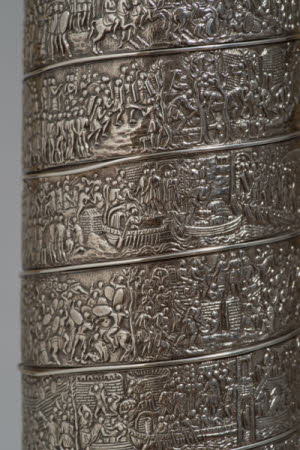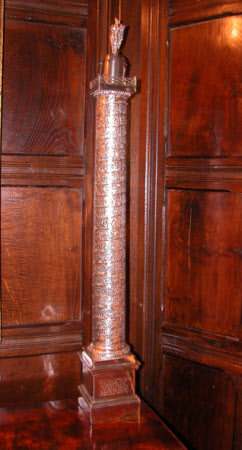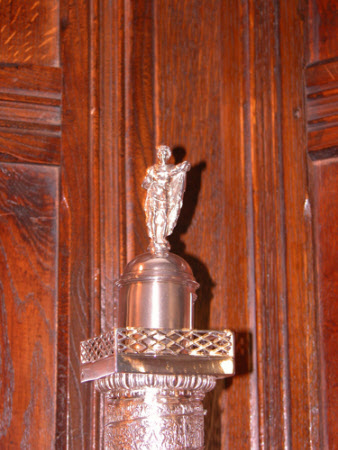A reduction of Trajan's Column
Stefano Fedeli (1794 - 1870)
Category
Art / Sculpture
Date
1815 - 1840
Materials
Silver
Measurements
794 x 103.8 x 104 mm
Place of origin
Rome
Order this imageCollection
Anglesey Abbey, Cambridgeshire
NT 516407
Summary
Silver, Reduction of Trajan's Column, Stefano Fedeli (1794-1870), 1815-40. A reduction in silver of Trajan’s Column in Trajan’s Forum in Rome, a victory column celebrating the martial feats of the Emperor Trajan (A.D. 52-117, ruled A.D. 98-117), dedicated in A.D. 113. A tall column embellished with a spiralling frieze of reliefs depicting events from Trajan’s campaigns against the Dacians. The spiral effect running up the column is accentuated by a length of silver wire that runs around the column, from a hole in the bottom and into one at top. At the top is a rectangular platform with lattice railings, upon which is a cylindrical construction, with a door, surmounted by a figure of an emperor with a shield. The column rests upon a rectangular base, at each top corner of which is an eagle, and the sides of which have relief decoration of piled weapons. In the front side is a panel with inscription and a fictive door. Separately-made elements held together internally with iron rod, weighted at base with section of lead. The copy was made by the Roman silversmith and founder Stefano Fedeli (1794-1870). The Column is the pair to a reduced copy of the Column of Marcus Aurelius (NT 516413), also by Stefano Fedeli.
Full description
Trajan’s Column is one of the most important and best-preserved monuments to survive in Rome from the Imperial period. It was erected during the lifetime of the Emperor Trajan, when he was at the height of his power and basking in the glory of his victories over the Dacians, a people who lived in an area to the west of the Black Sea, roughly the present-day countries of Moldova and Romania. Trajan conducted two successful campaigns in A.D. 101-02 and 105-06, and it was the booty that he brought back from the wars that allowed him to fund a project to build a large new forum and market complex, in which the Column was the focal point. It is one of two Victory Columns to survive largely intact in Rome, the other the Column of Marcus Aurelius. The sculpted relief decorations wind their way up the column, creating a narrative frieze that is more than 620 feet (190 metres) in length, the longest in the world. The narrative illustrates the two campaigns of conquest, the lower half illustrating the first (A.D. 101–102) and the top half the second (105–106); they are divided by a personification of Victory with a trophy of arms. The Column would originally have been surmounted by a statue of the emperor, which was missing by 1587, when Pope Sixtus V had a bronze statue of Saint Peter placed atop it. Interest in reproducing the friezes and making small reproductions of the Columns of Trajan and Marcus Aurelius began to grow from the later decades of the eighteenth century onwards. It was sparkedby the publication in 1774 by Giovanni Battista Piranesi of a series of engravings of Trajan’s column. A few years later, between 1779 and 1783, the goldsmith and founder Luigi Valadier made a reduction, albeit on a monumental scale, of Trajan’s Column in gilt-bronze, designed to contain the mechanism of a clock (Munich, Residenz, Schatzkammer: Alvar Gonzalez-Palacios, Luigi Valadier, New York/London 2018, pp. 221-24, fig. 5.15). Valadier’s magnificent rendition would inspire a series of further reductions of Trajan’s column, well into the nineteenth century. One of the best-known is a gilt-bronze reduction of Trajan’s column made by the goldsmith Giovacchino Belli (1756-1822) in 1819, in the Galleria d’Arte Moderna in Palazzo Pitti, Florence, which uniquely retains its original leather case (Inv. M.P.P. 1911, no. 10679. Kirsten Aschengreen Piacenti, ed., Curiosità di una reggia. Vicende della guardaroba di Palazzo Pitti, exh. cat., Palazzo Pitti, Florence 1979, p. 167, no. 128; Giovanni Agosti, Vincenzo Farinella and Giorgio Simoncini, eds., La Colonna Traiana e gli artisti francesi da Luigi XIV a Napoleone I, exh. cat., Villa Medici, Rome 1988, pp. 112-13; Stefano Susinno, ed., Maestà di Roma. Da Napoleone all’Unità d’Italia. Universale ed Eterna Capitale delle Arti, exh. cat., Scuderie del Quirinale et al., Rome 2003, p. 96, no. I.18). Giovacchino Belli and his son Pietro (1780-1828)also made over a period of seven years from 1808-15 the superb reductions in marble and gilt-bronze of the Arches of Septimius Severus and of Titus, bought by the Prince Regent in 1816 and today in the Royal Collection (RCIN 43916 and 43917; eds. Kate Heard and Kathryn Jones, George IV. Art and Spectacle, London 2019, pp. 187-88, figs. 14.3-14.4). As well as reductions of the two columns, reductions of the most famous obelisks to be seen in Rome were also popular in the late eighteenth and early nineteenth century. A pair is in Palazzo Pitti, Florence (Enrico Colle, Angela Griseri and Roberto Valeriano, Bronzi decorativi in Italia. Bronzisti e fonditori italiani dal Seicento all’Ottocento, Milan 2001, p. 234). In the early decades of the nineteenth century, reductions of the two columns and of the obelisks from the Piazza di San Giovanni Laterano and the Piazza del Popolo became typical gifts for the Pope to present to members of European ruling families (Alvar Gonzalez-Palacios, Il Tempio del Gusto. Le arti decorative in Italia fra classicism e barocco. Roma e il Regno delle Due Sicilie, 2 vols., Milan 1984, I, p. 169, figs. 323-26). For example, in 1817 Pope Pius VII commissioned a pair of gilt-bronze columns from the German-born founders Wilhelm Hopfgarten (1779-1860) and Ludwig Jollage,(1781-1837), for presentation as a gift at the conclusion of the Concordat between the Bavarian state and the Holy See (Hans Ottomeyer and Peter Pröschel, Vergoldete Bronzen. Die Bronzearbeiten des Späatbarock und Klassizismus, 2 vols., Munich 1986, I, p. 310, Taf. XLII, p. 404, Abb. 5.19.8). Hopfgarten and Jollage were among the most prolific manufacturers of reproductions of the columns in Rome, their casts of the two columns and of two famous obelisks in Rome among the most sought-after pieces produced in their foundry (Chiara Teolato, Hopfgarten and Jollage rediscovered. Two Berlin Bronzists in Napoleonic and Restoration Rome, Rome 2016, pp. 12-14, figs. 5-6). The casts by Hopfgarten and Jollage are though of modest quality, simpler in detailing and inferior overall to the silver reductions at Anglesey Abbey, which are among the most important objects of this type to have survived. The reduction of Trajan’s Column at Anglesey Abbey and its companion reduction of the Column of Marcus Aurelius (NT 516413), were made a Roman silversmith, Stefano Fedeli. Fedeli’s Trajan’s Column is almost the same size as Giovacchino Belli’s gilt-bronze reduction in Florence, whilst both are surmounted by very similar small figures of emperors. Fedeli’s two columns are impressive high-quality works, in which the overall forms of the columns and the complex figurative friezes are copied fairly closely. In order to give a stronger ancient Roman flavour to his reductions, Fedeli replaced the statue of Saint Peter with a notional figure of a Roman emperor, intended to represent Trajan. He reproduced the main inscription fairly accurately, but did not include a subsidiary inscription set up by Sixtus V to commemorate his restoration of the Column (for all the inscriptions, see Tyler Lansford, The Latin Inscriptions of Rome. A Walking Guide, Baltimore 2009, pp. 90-93, no. 3.2). Stefano Fedeli (Bulgari, I, p. 437; Dizionario Biografico degli Italiani, XLV Farinacci-Fedrigo, Rome 1995, pp. 610-11) became a master in 1815. In 1831 he married as his second wife Anna Pichler, daughter of the celebrated gem-engraver Giuseppe Pichler. Fedeli worked in a generally Neo-classical style, his workshops moving between various locations in central Rome over a career of more than fifty years. Among his major works is a large figure depicting the Return of Ulysses, formerly in the collections of the Earls of Jersey (Bulgari, I, Tav. 25). He also made various works for churches in Rome and a writing set for the city council of Spoleto. A number of his works, including a silver-gilt inkstand surmounted by a seated satyr, soup and sugar dishes and an oil lamp with the figure of a dancing woman in the style of Canova, were published by Salvatore Fornari (Gli Argenti Romani, Rome 1968, unpaginated but pp. 240-42). They give a good sense of the range of his work, within an overall neo-classical idiom. Fedeli’s mark, S and F with the number 125 within a diamond-shaped lozenge, was used by him between 1815 and 1866. The warranty mark, with a papal mitre between crossed keys within a shield (Bulgari, I, p. 32, no. 1690, was used between 1815 and 1870 for works at the second level of fineness of silver, 10.16 ounces (889/1000). Jeremy Warren 2020
Provenance
Bequeathed to the National Trust by Huttleston Rogers Broughton, 1st Lord Fairhaven (1896-1966) with the house and the rest of the contents.
Credit line
Anglesey Abbey, The Fairhaven Collection (The National Trust)
Marks and inscriptions
Side one, south-east face, with door: S.P.Q.R. IMP CAESARI DIVI NERVAE F NERVAE TRAIANO AVG GERM DACICO PONT MAXIMO TRIB POT XVII IMP VI COS VI P P AD DECLARANDVM QVANTAE ALTITVDINIS MONS ET LOCVS TANTIS RVDRIBVS (sic.) SIT EGESTVS [The Senate and People of Rome: to the Imperial Caesar Nerva Traianus Augustus Germanicus Dacicus, son of the Divine Nerva, Supreme Pontiff, vested with the power of the office of Tribune for the seventeenth time, acclaimed Emperor for the sixth, Consul for the sixth, Father of his Country, in order to demonstrate how high was the hillside removed through such mighty works] Side two, at bottom of base: Maker’s mark (S/125/F within rhomboid) and warranty mark (crossed keys below a liturgical umbrella) Side three, at bottom of column proper: Maker’s mark (S/125/F within rhomboid)
Makers and roles
Stefano Fedeli (1794 - 1870), silversmith
References
Bulgari 1958-74: Constantino G. Bulgari, Argentieri, Gemmari e Orafi d’Italia, 5 vols., Rome 1958-74 Bulgari Calissoni 1987: Anna Bulgari Calissoni, Maestri Argentieri Gemmari e Orafi di Roma, Rome 1987
